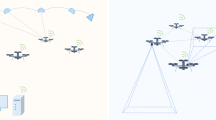Abstract
Sorting the swarm of robots is required when the robots are carrying different loads and they can not simply swap the loads. In 2016, Zhou et al. presented an interesting algorithm to sort a swarm of robots, wherein the authors made a main tree and a feedback tree to assign a topology to the robots, based on which the robots moved while arranging themselves in a sorted order. While the approach was very interesting and the results were critically analyzed by the authors, we see a critical problem that the approach did not account for collisions because of which the results can be very different. In this paper, we extend the work of Zhou et al. by enabling the robots to avoid collision by using a geometric approach called as “follow the gap” method. Together both the algorithms allow robot swarm to sort themselves in a straight line while avoiding collision simultaneously.














Similar content being viewed by others
References
Tan Y, Zheng Zy (2013) Research Advance in Swarm Robotics. Defence Technol 9(1):18–39
Navarro I, Mati̇a F (2013) An Introduction to Swarm Robotics. ISRN Robot 2013:1–10
Brambilla M, Ferrante E, Birattari M, Dorigo M (2013) Swarm robotics: A review from the swarm engineering perspective. Swarm Intell 7(1):1–41
Lei X, Fang M, Fujita H (2019) Moth-flame optimization-based algorithm with synthetic dynamic ppi networks for discovering protein complexes. Knowl-Based Syst 172:76–85
Al-zoubi AM, Mirjalili S, Fujita H, Lei X, Fang M, Fujita H (2018) An efficient binary salp swarm algorithm with crossover scheme for feature selection problems. Knowl-Based Syst 154:43– 67
Zhou Y, Goldman R, Mclurkin J (2016) An Asymmetric Distributed Method for Sorting a Robot Swarm. IEEE Robot Autom Lett 2(1):261–268
Sezer V, Gokasan M (2012) A novel obstacle avoidance algorithm: ”Follow the gap method”. Robot Auton Syst 60(9):1123–1134
Litus Y, Vaughan RT (2010) Fall in! Sorting a group of robots with a continuous controller. CRV 2010 - 7th Canadian Conference on Computer and Robot Vision, pp 269–276
Krupke D, Hemmer M, McLurkin J, Zhou Y, Fekete SP (2015) A parallel distributed strategy for arraying a scattered robot swarm. IEEE International Conference on Intelligent Robots and Systems 2015-December, pp 2795–2802
Chang EJ (1982) Echo algorithms: Depth parallel operations on general graphs. IEEE Trans Softw Eng SE-8 (4):391–401
Kala R (2018) Routing-based navigation of dense mobile robots. Intel Serv Robot 11(1):25–39
Golas A, Narain R, Curtis S, Lin MC (2013) Hybrid Long-Range Collision Avoidance for Crowd Simulation. IEEE Trans Vis Comput Graph 20(7):1022–1034
Shang B, Crowder R, Zauner KP (2014) Swarm Behavioral Sorting based on Robotic Hardware Variation. 4th International Conference On Simulation And Modeling Methodologies, Technologies And Applications (SIMULTECH), pp 631– 636
Kumar M, Garg DP, Kumar V (2008) Self-sorting in a swarm of heterogeneous agents. Proceedings of the American Control Conference, pp 117–122
Saad A, Khan SA, Mahmood A (2018) A multi-objective evolutionary artificial bee colony algorithm for optimizing network topology design. Swarm and Evolutionary Computation
Nitschke GS, Schut MC, Eiben AE (2012) Evolving behavioral specialization in robot teams to solve a collective construction task. Swarm and Evolutionary Computation
Ding H, Hamann H (2014) sorting in swarm robots using Communication-Based cluster size estimation. In: Dorigo M et al. (eds) Swarm intelligence. ANTS 2014. Lecture notes in computer science, vol 8667. Springer, Cham, pp 262–269
Kalles D, Mperoukli V, Papandreadis A (2012) Emerge-Sort : Swarm intelligence sorting. In: Maglogiannis I, Plagianakos V, Vlahavas I (eds) Artificial intelligence: Theories and applications. SETN 2012. Lecture notes in computer science, vol 7297. Springer, Berlin, pp 98–105
Ding H, Hamann H (2014) Sorting in swarm robots using communication-based cluster size estimation. Swarm Intelligence, Springer International Publishing, pp 262–269
Degener B, Kempkes B, Kling P, Meyer auf der Heide, F (2010) A continuous, local strategy for constructing a short chain of mobile robots. Structural Information and Communication Complexity. Springer, Berlin, pp 168–182
Khatib O (1986) Real-time obstacle avoidance for manipulators and mobile robots. Autonomous Robot Vehicles, pp 396–404
Fiorini P, Shiller Z (1998) Motion planning in dynamic environments using velocity obstacles. Int J Robot Res 17(7):760–772
Ye C, Webb P (2009) A sub goal seeking approach for reactive navigation in complex unknown environments. Robot Auton Syst 57(9):877–888
Degener B, Kempkes B, Kling P, Meyer auf der Heide, F (2010) A continuous, local strategy for constructing a short chain of mobile robots. In: Patt-Shamir B, Ekim T (eds) Structural information and communication complexity. Springer, Berlin, pp 168– 182
Acknowledgements
Authors would like to acknowledge Akanshi Mittal for her valuable contribution in producing a flawless document.
Author information
Authors and Affiliations
Corresponding author
Additional information
Publisher’s note
Springer Nature remains neutral with regard to jurisdictional claims in published maps and institutional affiliations.
Research supported by the Science and Engineering Research Board, Department of Science and Technology, Government of India through Research Grant ECR/2015/000406.
Rights and permissions
About this article
Cite this article
Kumar, U., Banerjee, A. & Kala, R. Collision avoiding decentralized sorting of robotic swarm. Appl Intell 50, 1316–1326 (2020). https://doi.org/10.1007/s10489-019-01602-5
Published:
Issue Date:
DOI: https://doi.org/10.1007/s10489-019-01602-5




